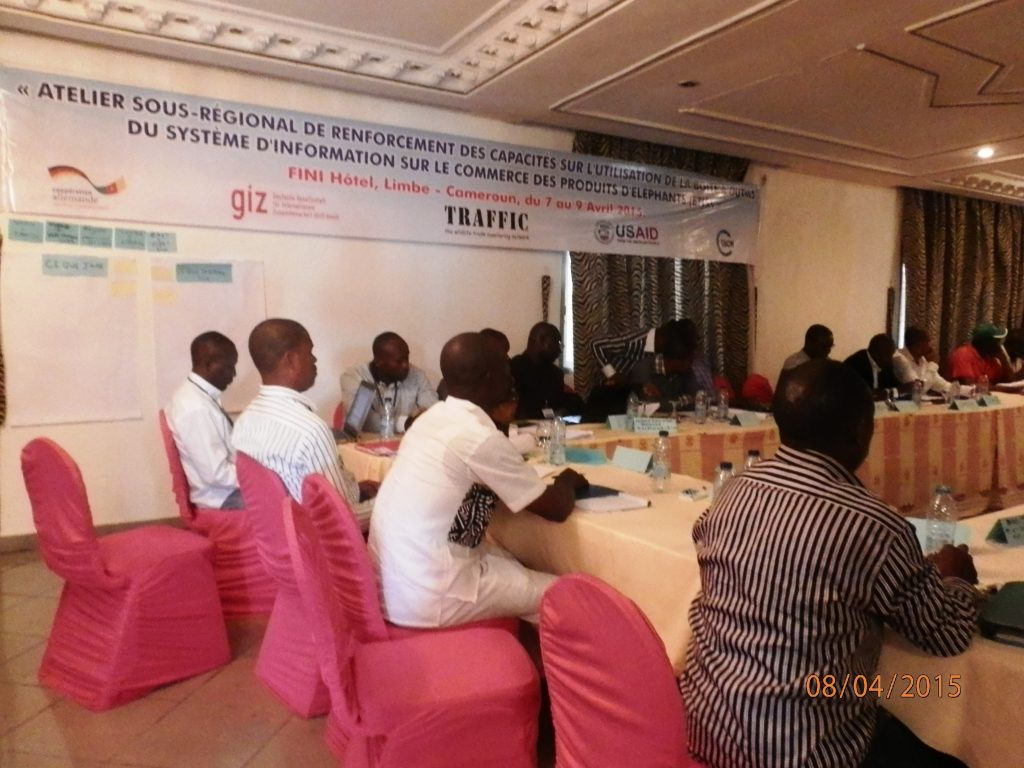Wildlife officials in Central Africa were, April 7-9, 2015 coached on the use of the Elephant Trade Information System (ETIS) to support wildlife law enforcement in the sub-region. The workshop organized by the Wildlife Trade Monitoring Network (TRAFFIC) took place in Limbe, South West Region of Cameroon.
By Mkong Immaculate Kelighai
Wildlife officials from Cameroon, DR Congo, Congo Brazzaville, Gabon and Central African Republic were trained on the use of the Elephant Trade Information System, a toolkit assembled by Convention on International Trade in Endangered Species (CITES) to enable forestry, customs, police and the judiciary to collect information on illegal elephant trade. The officials are expected to analyze information gathered from seizures and send to CITES for evaluation and, based on this information, conservation efforts in the sub-region can be gauged.
“The collection of this information is very important but people don’t know how to use the toolkit, and if you don’t know how to use the toolkit, you won’t be able to collect this information. From our observation during this workshop, 74% of participants did not even know that this toolkit exists. If Divisional Delegates in Cameroon don’t know about the ETIS form, how will the others know? They have done seizures and the information is sitting right there; they don’t even know how to transmit the information. We are training them how to collect seizure information; and how to make sure that it reaches CITES,” said Ngeh Paulinus, Central African Regional Director of TRAFFIC.
CITES has classified some countries as areas of primary concern which means that the situation of elephants in these countries is very critical. Some are of secondary concerns while others are just countries to watch. The five countries which took part in this workshop have been classified as countries of secondary concern.
Ngeh said the objectives of the workshop were met since participants now have an understanding of the ETIS toolkit.
“We did our analyses before the workshop and a majority of the participants didn’t know about the ETIS toolkit. I can confidently say now that people will go back home with knowledge on how to use the toolkit; that is the first indication of success. Also, from the participation and debates during the workshop, I think most of the people are really concerned; participants, especially those from Cameroon are already making proposals on how to harmonize the diversified method of collection that has been going on; they now agree that customs or gendarme officials should not collect and store information, there should be one focal point, that is the Ministry of Forestry and Wildlife (MINFOF) which will be in charge of forwarding the information to CITES. Some officials even collect and send information straight to CITES and the government never gets to know about it, which is not good,” Ngeh said.
One of the participants, Enoh Kenneth Eyong, Meme Divisional Delegate for Forestry and Wildlife, confessed his ignorance about the ETIS form before the workshop.
“I had never seen the ETIS form. This training has built our capacity on how to fill the form after every seizure and send to the right quarters. The world will now know the situation of elephants in each country. We are also going to use this information to train the other chiefs of post and chiefs of section on how to fill the form,” said Enoh Kenneth.
While seizure data are forwarded to CITES, the seized specimens stay in the country and follow the prescriptions of the law.
According to the Cameroon law, the Divisional Delegate stores the data in a safe place like the police, and specimens are later on moved to the final storage place which is the capital. Some countries like Gabon, after a while burn their stock piles of ivory.
The Central African sub-region harbours a good number of both forest and savannah elephants. Unfortunately, these elephants are continuously massacred on a large scale for ivory and other products. This workshop, therefore, came against a backdrop of disturbing reports from the CITES indicating a decrease in elephant population in the sub-region.
The elephants are now considered to be critically endangered, veering towards extinction if proper mechanisms are not put in place to protect them. The CITES reports say that the year 2011 witnessed the worst record on illegal ivory trafficking, with 46 tonnes of illegal ivory seized representing at least 5,000 slaughtered elelpahnts.
Wildlife Officials Coached To Curb Illegal Ivory Trade

OLYMPUS DIGITAL CAMERA